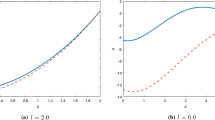Abstract
The paper addresses a thermoelectroelastic problem for a piezoelectric body with an arbitrarily shaped plane crack in a plane perpendicular to the polarization axis under a symmetric thermal load. A relationship between the intensity factors for stress (SIF) and electric displacement (EDIF) in an infinite piezoceramic body with a crack under a thermal load and the SIF for a purely elastic body with a crack of the same shape under a mechanical load is established. This makes it possible to find the SIF and EDIF for an electroelastic material from the elastic solution without the need to solve specific problems of thermoelasticity. The SIF and EDIF for a piezoceramic body with an elliptic crack and linear distribution of temperature over the crack surface are found as an example
Similar content being viewed by others
References
N. M. Borodachev, “The thermoelastic problem for an infinite axisymmetrically cracked body,” Int. Appl. Mech., 2, No. 2, 54–58 (1966).
V. T. Grinchenko, A. F. Ulitko, and N. A. Shul’ga, Electroelasticity, Vol. 1 of the six-volume series Mechanics of Coupled Fields in Structural Members [in Russian], Naukova Dumka, Kyiv (1989).
K. L. Johnson, Contact Mechanics, Cambridge University Press (1989).
V. S. Kirilyuk, “On the relationship between the stress intensity factors for plane cracks in isotropic and transversely isotropic materials,” Teor. Prikl. Mekh., 29, 3–16 (1999).
G. S. Kit and M. V. Hai, The Method of Potentials in Three-Dimensional Problems of Thermoelasticity for Cracked Bodies [in Russian], Naukova Dumka, Kyiv (1989).
M. P. Savruk, Stress Intensity Factors for Cracked Bodies, Vol. 2 of the four-volume handbook Fracture Mechanics and Strength of Materials [in Russian], Naukova Dumka, Kyiv (1988).
W. Nowacki, Issues of Thermoelasticity [Russian translation], Izd. AN SSSR, Moscow (1962).
V. Z. Parton and B. A. Kudryavtsev, Electroelasticity of Piezoceramic and Conductive Bodies [in Russian], Nauka, Moscow (1988).
Yu. N. Podil’chuk, “Representation of the general solution of statics equations of the electroelasticity of a transversally isotropic piezoceramic body in terms of harmonic functions,” Int. Appl. Mech., 34, No. 7, 623–628 (1998).
Yu. N. Podil’chuk, “Exact analytical solutions of static electroelastic and thermoelectroelastic problems for a transversely isotropic body in curvilinear coordinate systems,” Int. Appl. Mech., 39, No. 2, 132–170 (2003).
Yu. N. Podil’chuk and Ya. I. Sokolovskii, “Thermostress in an infinite transversally isotropic medium with an internal elliptical crack,” Int. Appl. Mech., 30, No. 11, 834–840 (1994).
Y. Murakami, Stress Intensity Factors Handbook, Vol. 2, Pergamon Press, New York (1987).
H. G. Beom, Y. H. Kim, C. Cho, and C. B. Kim, “Asymptotic analysis of an impermeable crack in an electrostrictive material subjected to electric loading,” Int. J. Solids Struct., 43, No. 22–23, 6869–6886 (2006).
F. M. Chen, M. H. Shen, and S. N. Chen, “An exact thermopiezoelasticity solution for a three-phase composite cylinder,” Int. J. Eng. Sci., 44, No. 20, 1482–1497 (2006).
W. Q. Chen and C. W. Lim, “3D point force solution for a permeable penny-shaped crack embedded in an infinite transversely isotropic piezoelectric medium,” Int. J. Fract., 131, No. 3, 231–246 (2005).
L. Dai, W. Guo, and X. Wang, “Stress concentration at an elliptic hole in transversely isotropic piezoelectric solids,” Int. J. Solids Struct., 43, No. 6, 1818–1831 (2006).
M. K. Kassir and G. C. Sih, Three-Dimensional Crack Problems, Vol. 2 of the series Mechanics of Fracture, Nordhoff, Leyden (1975).
M. K. Kassir, “Thermal crack propagation,” in: Trans. ASME, Ser. D, J. Basic Eng., 93, No. 4, 642–648 (1971).
S. A. Kaloerov, “Determining the intensity factors for stresses, electric-flux density, and electric-field strength in multiply connected electroelastic anisotropic media,” Int. Appl. Mech., 43, No. 6, 631–637 (2007).
V. S. Kirilyuk, “On the relationship between the solutions of static contact problems of elasticity and electroelasticity for a half-space,” Int. Appl. Mech., 42, No. 11, 1256–1269 (2006).
V. S. Kirilyuk, “Stress state of a piezoelectric body with a plane crack under antisymmetric loads,” Int. Appl. Mech., 42, No. 2, 152–161 (2006).
V. S. Kirilyuk and O. I. Levchuk, “Electrostressed state of a piezoceramic body with a paraboloidal cavity,” Int. Appl. Mech., 42, No. 9, 1011–1020 (2006).
X. F. Li and K. Y. Lee, “Three-dimensional electroelastic analysis of a piezoelectric material with a penny-shaped dielectric crack,” J. Appl. Mech., 71, No. 6, 866–877 (2004).
F. Shang, M. Kuna, and T. Kitamura, “Theoretical investigation of an elliptical crack in thermopiezoelectric material. Part 1: Analytical development,” Theor. Appl. Fract. Mech., 40, No. 3, 237–246 (2003).
S. Ueda, “A finite crack in a semi-infinite strip of a grade piezoelectric material under electric loading,” Eur. J. Mech., A/Solids, 25, No. 2, 250–259 (2006).
Z. K. Wang and B. L. Zheng, “The general solution of three-dimension problems in piezoelectric media,” Int. J. Solids Struct., 32, No. 1, 105–115 (1995).
B. L. Wang and Y. W. Mai, “Impermeable crack and permeable crack assumptions, which one is more realistic?” J. Appl. Mech., 71, No. 4, 575–578 (2004).
T. Y. Zhang and C. F. Gao, “Fracture behaviors of piezoelectric materials,” Theor. Appl. Fract. Mech., 41, No. 1–3, 339–379 (2004).
Author information
Authors and Affiliations
Additional information
__________
Translated from Prikladnaya Mekhanika, Vol. 44, No. 3, pp. 96–108, March 2008.
Rights and permissions
About this article
Cite this article
Kirilyuk, V.S. Thermostressed state of a piezoelectric bodywith a plane crack under symmetric thermal load. Int Appl Mech 44, 320–330 (2008). https://doi.org/10.1007/s10778-008-0048-8
Received:
Published:
Issue Date:
DOI: https://doi.org/10.1007/s10778-008-0048-8




